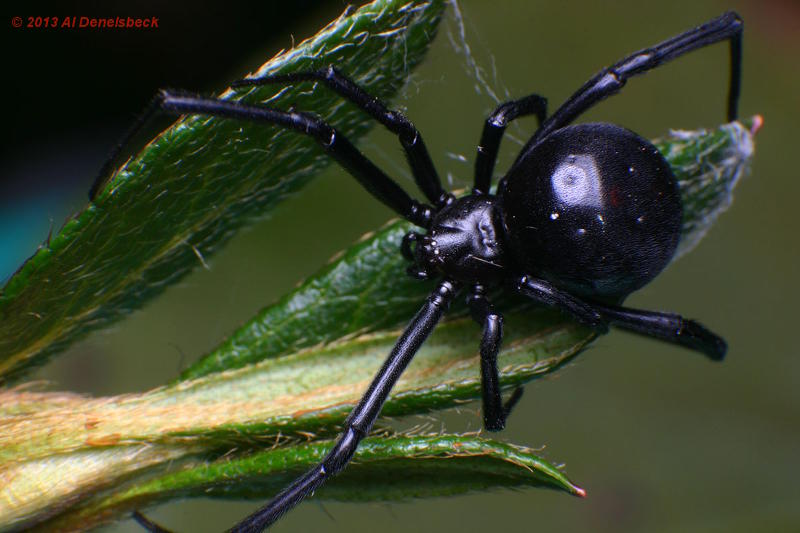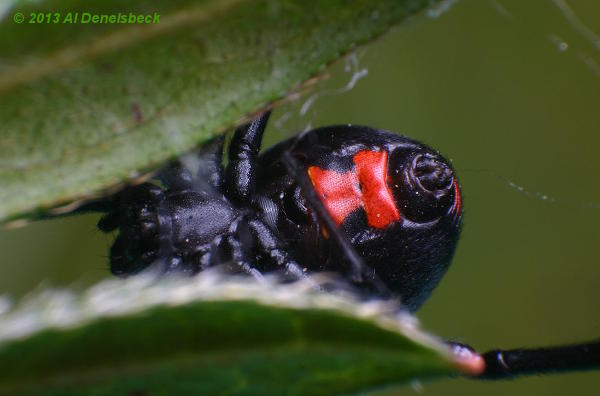[All] Canon
300D, handheld
Sunpak FP38 flat panel flash with softbox/diffuser
ISO 200
f16, 1/200 second
[Top, Middle] Mamiya 80mm macro w/ extension
[Bottom]
Sigma 28-105 reversed at 28mm, f16
[All] Canon
300D, handheld |
| Lonely widow | |
 |
|
Yeah, that title sounds like a porn film, doesn't it? Maybe it will bring more hits to this page, because I'm betting it will be one of the least-clicked pages on the site ;-)
 Black widows are one of the few arthropods that most people know the identifying markings of – or at least, think they do. In truth, the hourglass mark on the belly can vary pretty widely, in shape and coloration, and the two triangular 'halves' can be separated. There are also a variety of dorsal markings that can be found, some signifying one of two species, some signifying 'instars' or growth stages – the juveniles can look distinctly different from the adults, and the males are almost unrecognizable as the same species.
Black widows are one of the few arthropods that most people know the identifying markings of – or at least, think they do. In truth, the hourglass mark on the belly can vary pretty widely, in shape and coloration, and the two triangular 'halves' can be separated. There are also a variety of dorsal markings that can be found, some signifying one of two species, some signifying 'instars' or growth stages – the juveniles can look distinctly different from the adults, and the males are almost unrecognizable as the same species.
Since the hourglass is complete here, with a faint red spot just barely visible above the spinnerets and no markings on the 'back,' that marks this one as a southern black widow (Latrodectus mactans) – the northern variant has a hourglass split at the waist and markings on the upper abdomen. Both can be found in North Carolina, and in fact I have found both in our yard, but despite the fact that they're residents and that I'm frequently out looking for whatever arthropods I can find, I really don't see many of them, and when I do they're secreted away from nearly all possible contact, because that's their nature.
The original page that I had here showed different images, and I lamented that I had not yet managed to snag a particular feature, but that was in 2012; in 2013 I got what I was after, so during the later updates to the galleries I switched over the images.
These all came from a 'studio' session, using one that I'd captured and set loose on a small branch supported in a shallow pan of water (this was done on the porch because I would have been in deep trouble had I attempted to bring her into the house.) I knew my subject here would be trying to get under cover and would attempt to abandon the branch, but unlike many arachnid species, widows cannot support their weight on the surface tension of water, and so this was a functional deterrent. She did indeed try to escape, and when she lowered herself down on a strand of web, forelegs gently stroking the air seeking purchase, it was easily one of the creepiest things I've seen in my life – sociologists are still unclear as to whether phobias can be instinctual/inherited or are culturally introduced, so the arachnophobia that I grew up with may have been genetic, or might have been introduced from some experience that I had growing up, but either way, this little experience told me it's still hiding there in the background of my mind. And yes, my 'handling' was still done circumspectly; even though I knew I could let her run across my hand and wouldn't receive a bite unless I pinned her down, it wasn't happening.
But the image that I was after is below, an actual face shot. The eyes are incredibly tiny, arranged in two rows of four, with the anterior median (front middle) two on a raised bump. The shiny black chitin of widows is hard to light effectively, and maybe someday I'll achieve some even better shots, including of the chelicerae ('fangs') which are also tiny. This'll do for now, I suspect.

